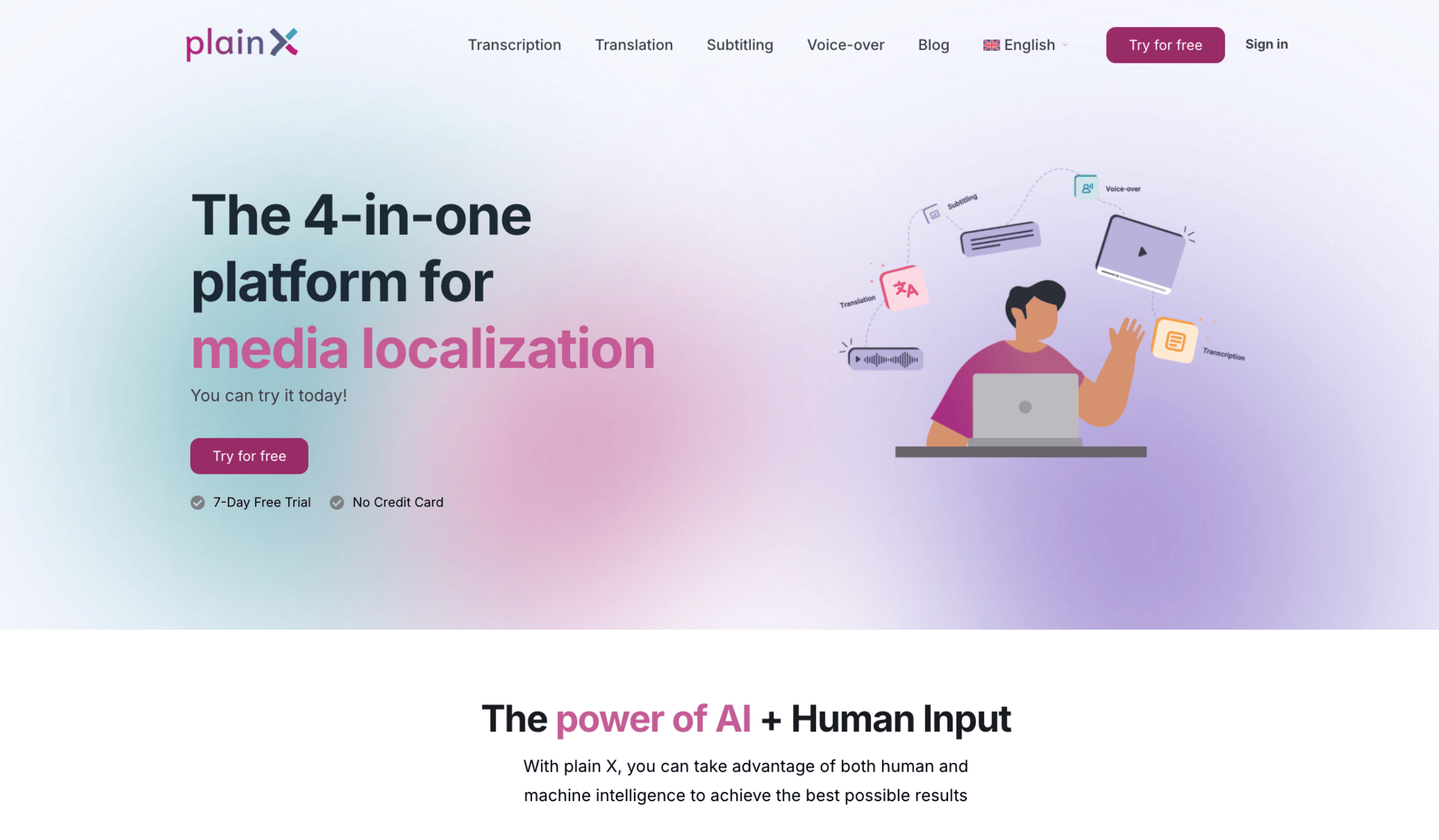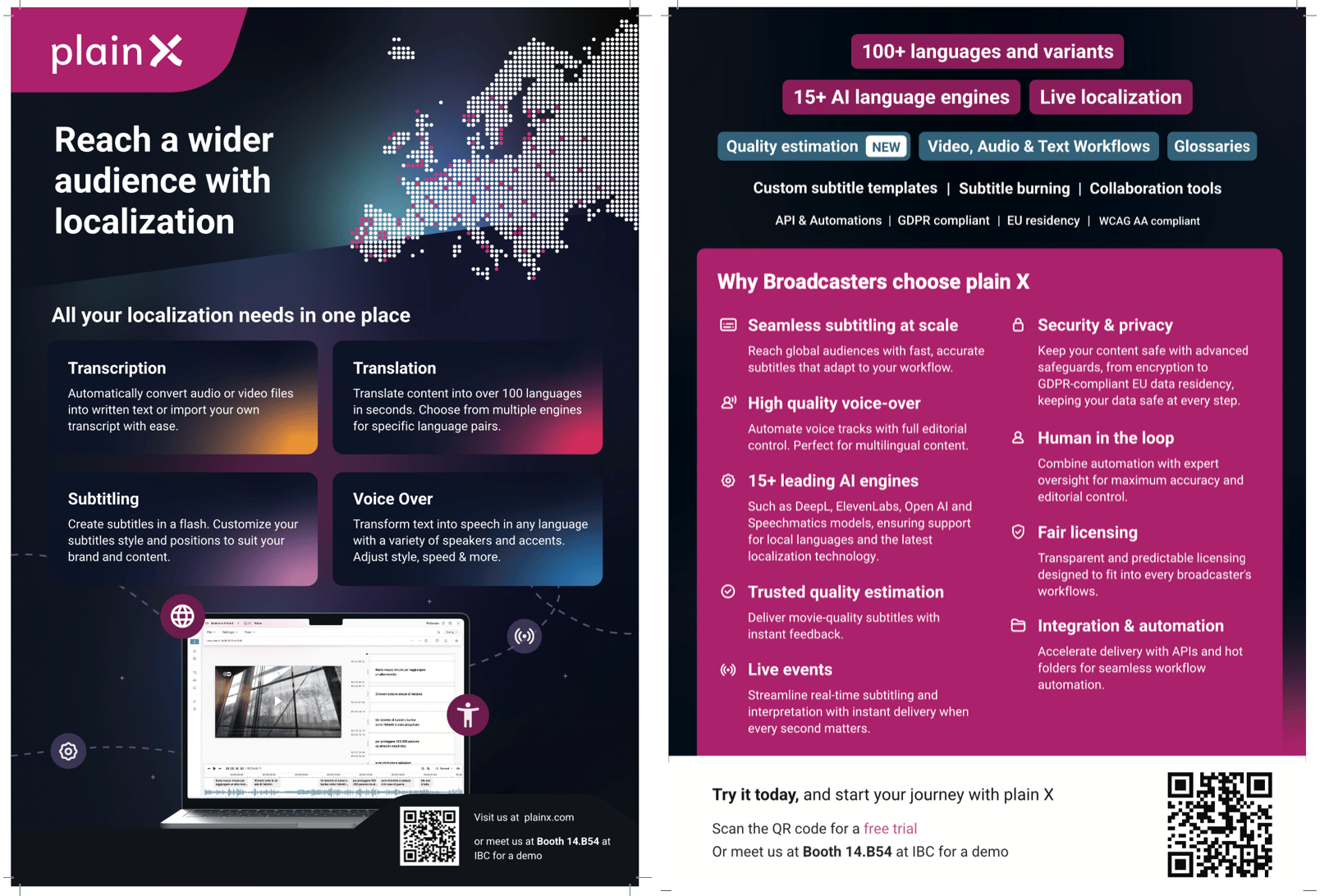
Demonstrating the workflow: Mirko Lorenz shows me how to use the interface of plain X
Global broadcasters like Deutsche Welle and the BBC face a dilemma - they want to offer their content in as many languages as possible, but manual content adaptation eats up time and budget. At the same time, they can't relinquish quality control. The solution doesn't lie in fully automated AI, but in intelligent support with "humans in the loop." Deutsche Welle, together with Priberam, a Portuguese specialist in Natural Language Processing (NLP), has developed a platform for exactly this purpose: plain X.
I spoke with Mirko Lorenz about what the platform delivers and which users benefit most from it. He is Innovation Manager in the Research and Cooperation Team (ReCo) at Deutsche Welle in Bonn, a department which aims to develop new technology solutions for DW and for journalism in general. ReCo, unlike the main company, is not financed from the federal budget but primarily through funding from EU and German research projects to participate in international research and innovation projects.
Mirko Lorenz is also the founder of Datawrapper. The data journalism tool, launched in 2012, is now used by around 600 major newsrooms worldwide, has one million registered users, and produces 10,000 charts daily. Full disclosure: Mirko Lorenz and I have known each other since our early journalism days. More than 30 years ago, we were both freelance contributors to the nationally distributed university magazine Unicum.
But now, on to plain X:

A 4-in-1 platform for content adaptation
plain X combines four functions in a collaborative work environment:
Transcription of audio and video to text
Translation into over 100 languages
Subtitling with customizable templates for different platforms
Voice-over with various voices and accents
What makes it special: The platform was developed from research for real life business solutions. "This is a rare example of a real product coming out of scientific research," explains Lorenz. Deutsche Welle's Research and Cooperation Team has been working in "Human Language Technologies" for 10 years - experience that fed into the development of plain X.
Deutsche Welle holds a stake in the project and has been using plain X itself as a standard tool for nearly two years, with full integration into the production environment and connection to cloud services. plain X is operated and developed by the company Priberam, based in Lisbon. The two partners met through joint research projects. The Portuguese team brings decades of language expertise - the company has been running the largest online dictionary for Portuguese since 1996.
Not automation, but collaboration
The crucial difference from many AI tools: plain X is designed for journalistic quality assurance. While content creators are being forgiven for using quick automated YouTube video subtitling, that would be unacceptable for DW. "We can't suddenly accept a bunch of typos. That would mean giving away our competence and credibility," says Lorenz.
The platform allows you to comment on transcripts, check the spelling of names, or invite native speakers for review and to create glossaries. These glossaries ensure that names and technical terms are written consistently. Former British Prime Minister Rishi Sunak’s name, for example, is written with a Z by most transcription systems. "With glossaries, we can prevent spending a week changing Zunak to Sunak during the transition to Keir Starmer," says Lorenz.
Multi-engine approach for best quality
plain X is "engine-agnostic"—the platform currently connects to 15 transcription services and eight translation engines, including Azure, Google, Whisper, DeepL, and ElevenLabs Scribe. The advantage: You can choose the best available engine for each task.
The quality of language engines varies greatly by language and especially language pairs. DeepL is used for about 70 percent of all cases, but for "low-resource languages"—languages with less training material—specialized engines can be better. ElevenLabs Scribe, for example, works well for Kiswahili, important for the German public broadcaster Westdeutscher Rundfunk (WDR) that has a studio in Nairobi.
The approach deliberately supports small, specialized providers like OpenTrad (Galician, Catalan) or Lesan AI (Amharic). "We expect that through linguistic focus, a small engine can become better in the long run than a large generic one. At Google, Galician just runs along, they're not really interested in it. OpenTrad, on the other hand, does nothing but Galician," explains Lorenz.
plain X also enables the use of synthetic voices. But this function is currently only used for very specific use cases. "The currently available voices are already very good. But our sense of hearing is even more finely developed than our sense of sight. An artificial voice that sounds really good in isolation still doesn't work for a longer documentary," says Lorenz. The current generation of speech technology works well for short news videos. But longer documentaries still lack crucial subtleties—nuances, speech pauses, changing emotions that we immediately pick up on in real speech.
Real-world use: From Lusa to Doha Institute
In addition to Deutsche Welle, users include public broadcaster WDR, Lusa (Portugal's news agency), CNN Portugal, and ChatEurope (AFP, dpa, El País), all using the platform in regular operations.
Lusa deploys plain X with 80 editors daily - but not for video adaptation, rather for transcripts. "Editors need the original quotes from politicians that ran in the morning shows, and transfer them into a text stream," explains Lorenz.
The Doha Institute in Qatar uses plain X pro bono. Journalism students work with it for transcription, translation, and subtitling. "This helps us better understand the quality of transcription and translation when dealing with Modern Standard Arabic and regional dialects," says Lorenz.
Time savings and workflow integration
plain X promises up to 85 percent time savings for transcription, up to 80 percent for translation, and up to 95 percent for subtitling and voice-over. These efficiency gains are based on templating options and the application of subtitling rules.
Critical for professional use: Integration into existing workflows. At Deutsche Welle, plain X is connected to internal systems. This allows texts, audio, and especially videos to be processed in plain X, with results sent to Adobe Premiere for final editing, for example.

plain X Flyer at the International Broadcasting Convention (IBC) in Amsterdam in September 2025, Credit: plain X
Not just for global news organizations
Smaller newsrooms can also benefit. The pricing model is volume-based with no monthly fees, including a seven-day free trial.
Lorenz sees particular potential for networks: "Imagine if we could enable networks of investigative journalists to easily translate their content into 30 languages with this tool—that would be no problem. They might not need it frequently, but when it matters, they could offer a quickly scaled 30-language translation done overnight."
To enable such usage models, plain X uses volume-based billing—the number of editors isn't a factor in pricing. “Otherwise, we'd make temporary teamwork almost impossible, but precisely this form of collaboration is important," adds Mirko Lorenz.
Public broadcasters could also better reach their communities. Lorenz cites a German example: "Why don't we have a Ukrainian program where our content is translated into Ukrainian? The refugees would be grateful, and a ten-minute daily update would be enough."
The bigger mission: Reaching new audiences with fact-based journalism
For Lorenz, it's about more than efficiency: "The internet offers an enormous amount of information, which is precisely why context matters. What's true is currently bitterly disputed. Climate change denial is just one example. Conveying knowledge here, constantly providing facts - that’s important. And it's easier when you speak the respective language."
For years, Deutsche Welle has pursued a strategy of reaching users through each country's popular platforms—Facebook, Instagram, YouTube, or TikTok. As a result, DW now reaches 337 million users per week and reports as an international broadcaster in 32 languages worldwide. "When you meet people from South America, Africa, or Asia, you often encounter Deutsche Welle viewers. People recognize that DW strives to offer balanced reporting. This is in demand in times with sometimes very extreme political styles and viewpoints," emphasizes Lorenz.
plain X is a tool to advance this strategy—not through blind automation, but through intelligent support of journalistic work with clear quality control.
My 5 learnings for journalists and newsrooms
For individual journalists:
AI tools should enable collaborative work, not isolated individual solutions. The ability to leave comments and use glossaries prevents errors from spreading through the entire workflow.
Transcripts, translations, and subtitles expand the number of potential users; AI reduces the cost of this adaptation.
For small newsrooms with minority languages:
Specialized smaller engines can deliver better results for less common languages than generic large providers. It's worth looking for language-specific solutions rather than just relying on the big names.
For mid-sized newsrooms:
Modular use is crucial: You don't have to use all features. Some newsrooms only need transcription for text output, others only subtitling for social media. The investment pays off even with selective use.
For global news organizations:
Being "engine-agnostic" is more important than being tied to one provider. The AI landscape is evolving quickly—those who can flexibly switch between different engines remain competitive and can choose the best available solution for each language.
For all newsrooms:
AI deployment should be driven by journalistic mission, not by technology. The question isn't "What can we do with AI?" but "What problem do we want to solve?"—then AI can be the right tool.
